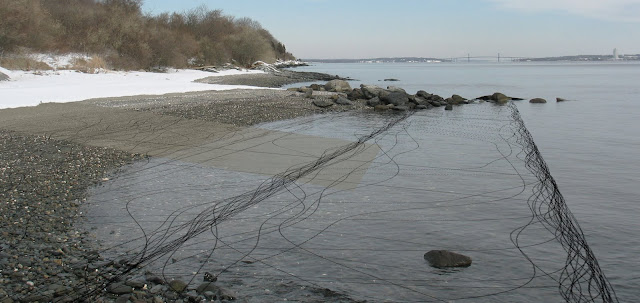DYNAMIC EDGE
This photographic exploration of shifting boundaries establishes the conceptual orientation of this thesis. It captures the movement of torn edges of trace within a single image where the expansion and contraction of the edge elicits the rhythm of tides along a shoreline. Layers of torn trace were manipulated by breath and captured in a series of equal exposures. The photograms illuminate this process in a composite product that attempts to address notions of change, time, and motion in a single frame.
The photograms were then used as the base for a Power Point animation, stills from which appear on the facing page. My intention for the animation was to use dynamic edges to create a sense of fluid space and to explore how an edge can take on a dimensionality. The space was to remain scaleless in its ever changing delineations and blurred conceptions of orientation. These intentions were conveyed through a series of shifting boundaries and by using processes of layering and accumulation in mark making. Slow movement and transitions were used deliberately to imply the seamless nature of fluidity.
VAPOR, LIQUID, SOLID
A single frame captures implied motion or fluidity in the mapping of each of the three distinct physical states of water by activating water as a material or surface in the construction of negatives. Wax, synthetic water, and condensation were used as active materials that were then recorded in a static state to illustrate the visual continuities and disparities between three forms of water. Time, light, and the ephemeral qualities of water become clear factors in these comparisons of the prints. In these terms, water is understood both culturally and ecologically; the term fluid is considered to be both adaptable and aqueous. Culturally water is considered to be evocative; have strong aesthetic potential, especially in its interplay with light; carry a degree of magnitude; serve as a context for commercial, spiritual, and recreational practice; and provide a great resource of sustenance for communities. Ecologically water is seen not only in terms of resources but also in terms of natural processes, from the smaller scale of tides and currents to the larger scale of climate change and sea level rise.
The prints were then imported into Rhinoceros and extruded as a height field in order to understand the forms as three-dimensional surfaces that acted as dynamic terrains.



THE FRESH/SALTWATER EDGE
This series of photograms illuminates surface tension particular to the active condition where fresh and salt water meet. An instance of movement was captured by using light to register the surface tension. The study was conducted by pouring salt water at the average temperature and salinity levels of Narragansett Bay into fresh water at the same temperature. The photogram series captures the freshwater prior to the introduction of salt water pour, the fresh/saltwater edge at initial impact, mid-stream of the pour, end of the pour, and after the saltwater has settled to the bottom of the tank. The first iteration of the study (the first set of five photos) was conducted by stopping between each photo, while in the second iteration of the study (the second set of five photos) the pour was continuous.
DISSOLVING TOPOGRAPHY
A mapping of fluid edge conditions and surface tension through the dilution of salt conveys an experience over time to eventually reveal existing site conditions, arriving at the average salinity level and temperature of Narragansett Bay at South Prudence Island. Surface tension and the expanding boundary of the fresh/saltwater edge were explored once again in this study of dissolving salt. The study was conducted by adding water in exponential ratios to a set amount of salt (1:0, 1:1, 1:3, 1:10, 1:33) ending in the ratio that is the average salinity level of Narragansett Bay.
Like the Vapor, Liquid, Solid study, the prints were then imported into Rhinoceros and extruded as a height field in order to map the study as a series of three-dimensional surfaces of dissolving topographies. A natural process is not only observed in this exercise but is activated as a potential design tool in the creation of site specific yet artificial topographies.
As a series of conceptual studies, Dynamic Edge, Vapor, Liquid, Solid, The Fresh/Saltwater Edge and Dissolving Topography investigate the terms of fluidity, natural processes, terrain, and edge within a photographic frame. A literal lens was created to frame perceptions of the dynamic edge with results that are applicable beyond the darkroom. These terms and prints will continue to focus the exploration of the coastal dynamic edge in a series of place-based mappings and in the physical manifestation of the proposed design.
As this investigation moves forward from conceptual studies to site-specific studies it carries with it a series of questions:
How can the built environment honor the fluidity of water and time?
Are there moments where natural and cultural processes are synonymous?
How can terrain be illuminated beyond its perceived boundaries?
How does an edge take on dimensionality?
How can a frame expand and contract?




































No comments:
Post a Comment